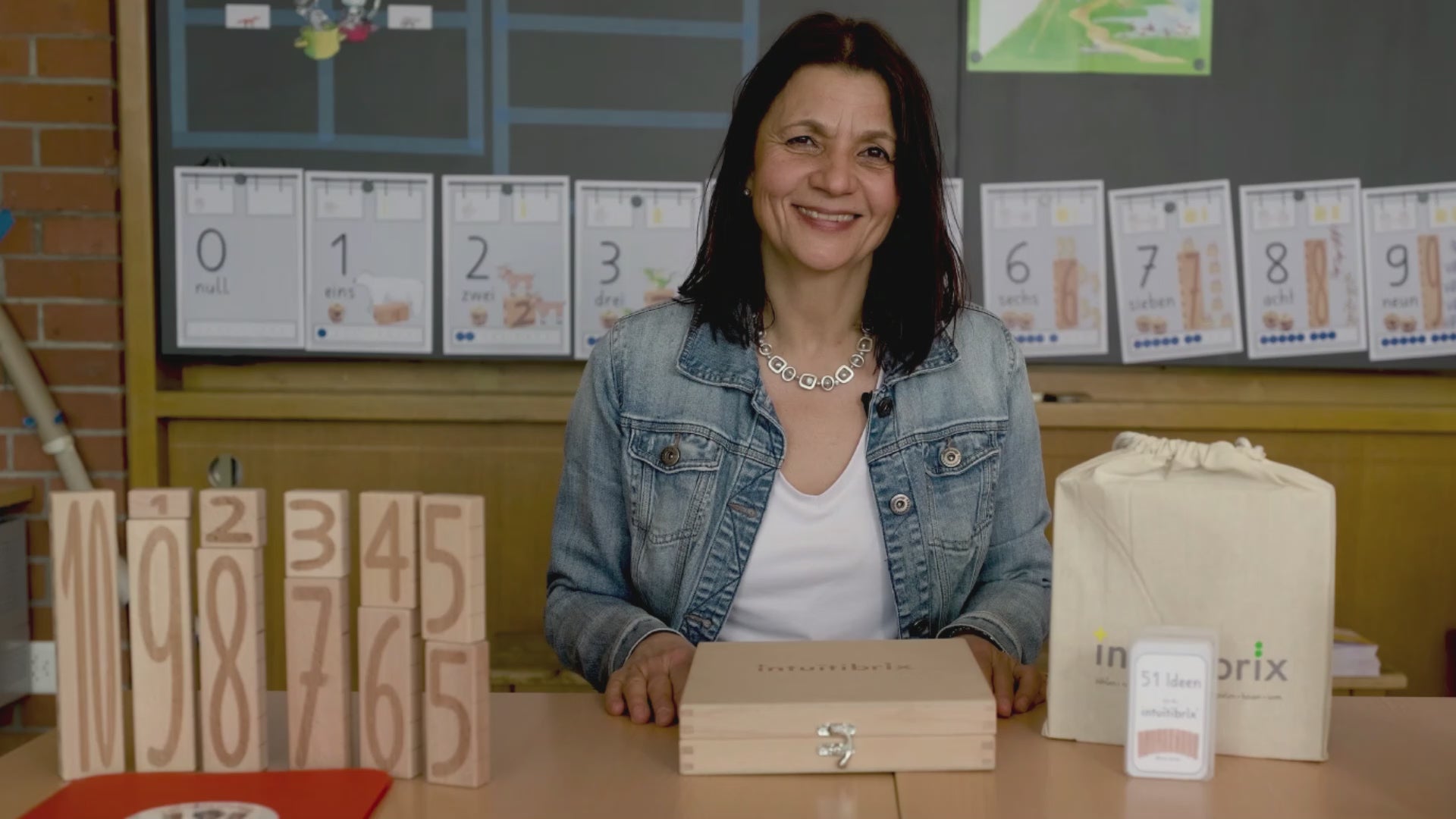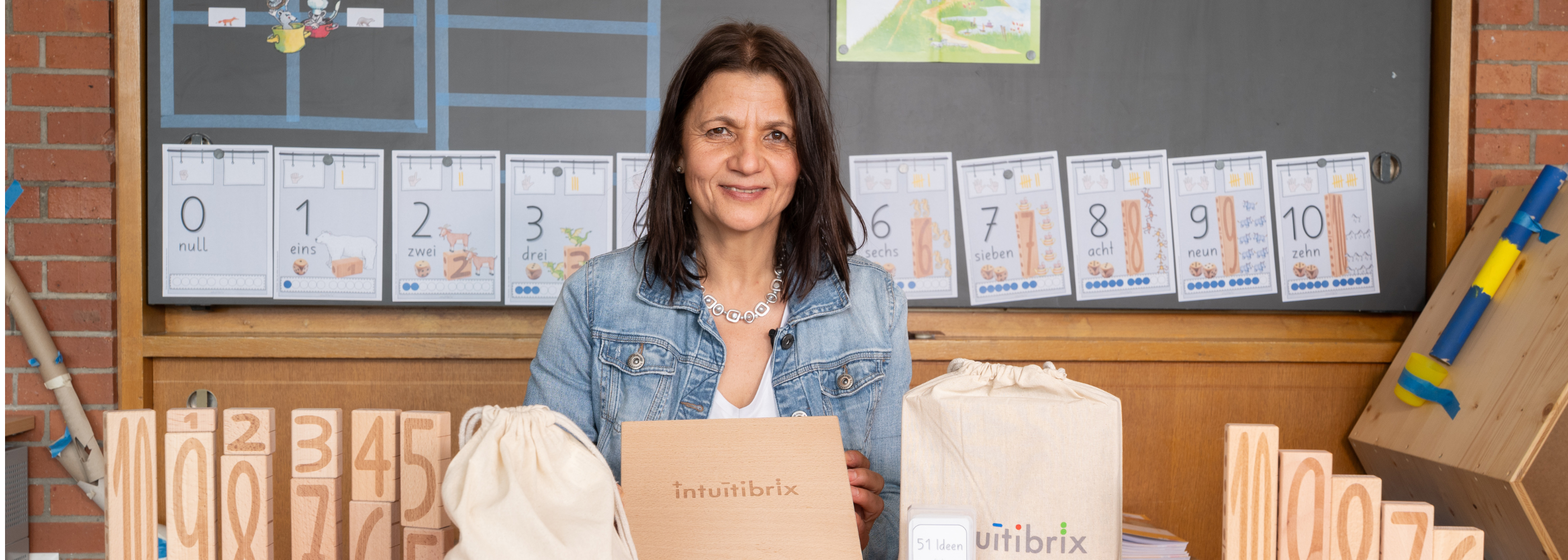How did Intuitibrix come about?
In my long career as a teacher, I’ve always searched for materials that encourage children to think and help them understand learning content, rather than just memorizing it. The market is vast, and there’s meaningful material, but also completely pointless or even harmful material. Many materials require the help of adults, but children want to discover things for themselves, and adults don’t always have time.
The challenges of recent years, such as teacher shortages, missed classes, children with insufficient language skills, etc., make it difficult for parents and professionals to adequately support and challenge children. So, it’s important to have materials that are simple to use and require little explanation. Moreover, they should motivate children and guarantee their learning success.
I asked children what they most enjoy doing. Besides gaming, painting, and playing soccer, the answer was often: BUILDING. How lucky! This motivated me to develop building blocks with numbers, grooves, and dots that constantly remind children of the number and quantity of each block. For example, you can see that the 6 is just an upside-down 9 as a digit. They are not the same size.
I’ve managed to integrate practically all the mathematical aspects that are important in early education into Intuitibrix. The more I work with it and ask people in my environment, the more we discover how much math is embedded in the material. So, it won’t get boring quickly.
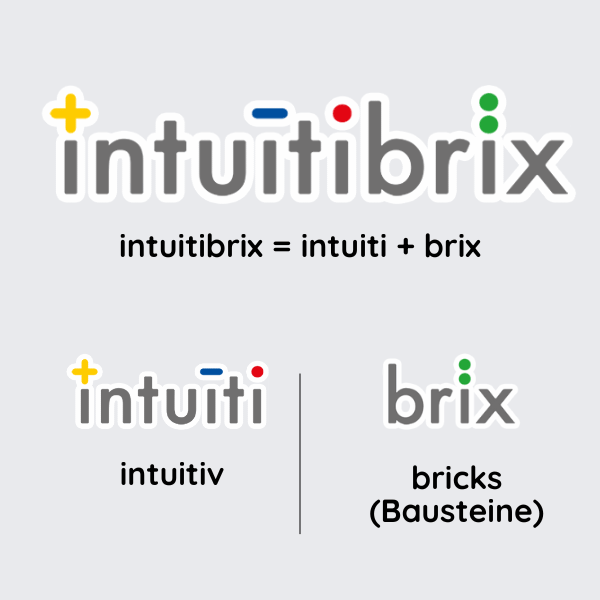
What does intuitibrix mean?
Intuiti comes from intuitive and 'brix' from the English word 'brick.' It thus means intuitive learning with building blocks. I wanted four 'i's to represent the four mathematical operations in the logo. Through working with the blocks, mathematical insights are provoked. There is no right or wrong. By building, number and quantity relationships are discovered, basic geometric experiences are made, and creativity is stimulated. Children benefit the most when their curiosity is allowed to run free. Adults can admire what the child has built or simply build along with them.
Nevertheless, many learning contents from primary school, basic school, and elementary school curricula can be represented with the blocks.
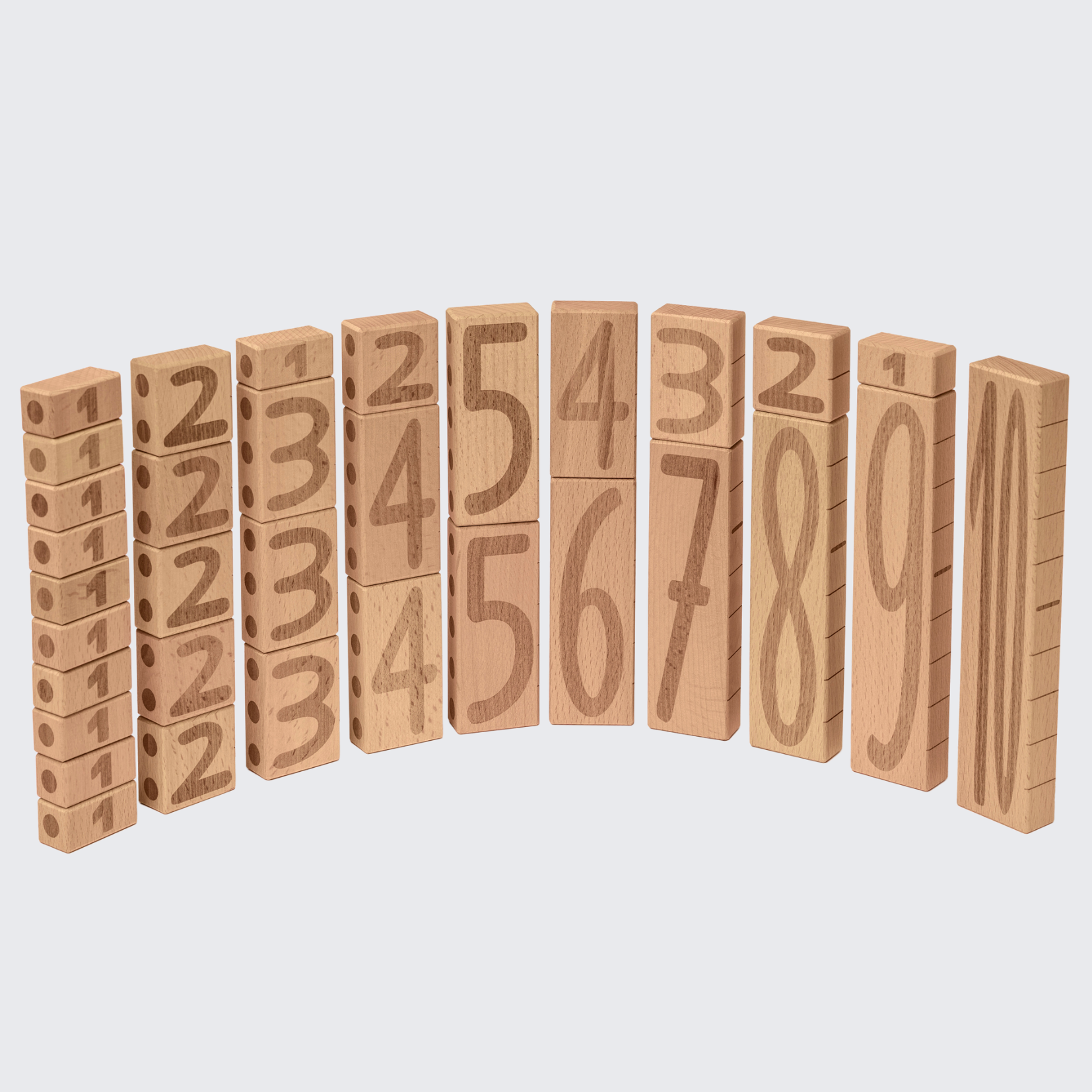
Number of building blocks
The basic Intuitibrix set in the box or in the fabric bag consists of 1 ten, 1 nine, 1 eight, 1 seven, 1 six, 2 fives, 3 fours, 4 threes, 7 twos, and 12 ones. The blocks from 6 to 10 are each available only once. So, if I want another ten, for example, I MUST assemble it from smaller blocks.
Each block is available in a quantity that allows you to build at least the height of the ten with identical blocks.
10 + 9 + 8 + 7 + 6 + 2 x 5 + 3 x 4 + 4 x 3 + 7 x 2 + 12 x 1 = 100
If there were only single blocks, it would be exactly 100. Each row represents 10 blocks. With 2 rows, it's 20, with 3 rows, 30, and so on. All numbers up to 100 can be practiced this way. A helpful tool are the number cards, which are available as a download in the shop.
The "Numbers in Love" set includes the blocks from 1 to 10, each once. Only the 5 is doubled, allowing all tens decompositions to be represented.
The mini set includes the blocks from 1 to 10, each 10 times. This allows the numbers up to 100 to be represented more quickly and all the problems of the small multiplication can be easily solved. The minis are only half the size of the blocks in the other sets. They have a base area of 1 x 2 cm.
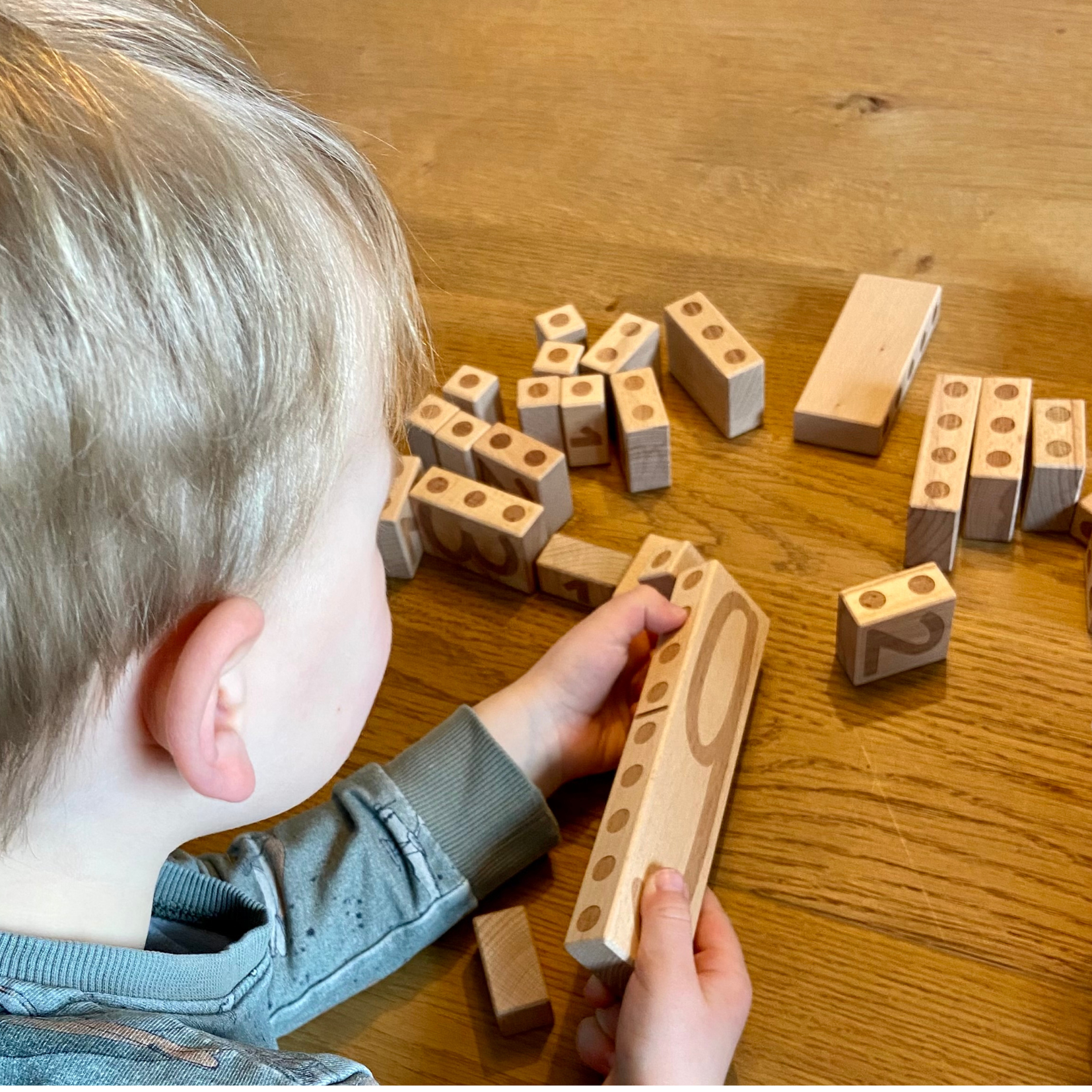
Counting
To know the height of each block, you can count the dots or fields on the sides. Sometimes children may count the lines instead of the fields. In this case, the corresponding block can be rebuilt with ones, counted, and then compared. It’s even easier if the child counts the dots directly.
Counting is an important skill. First, children need to learn the sequence of numbers. After that, they need to understand that each number word corresponds to an object/field/dot.
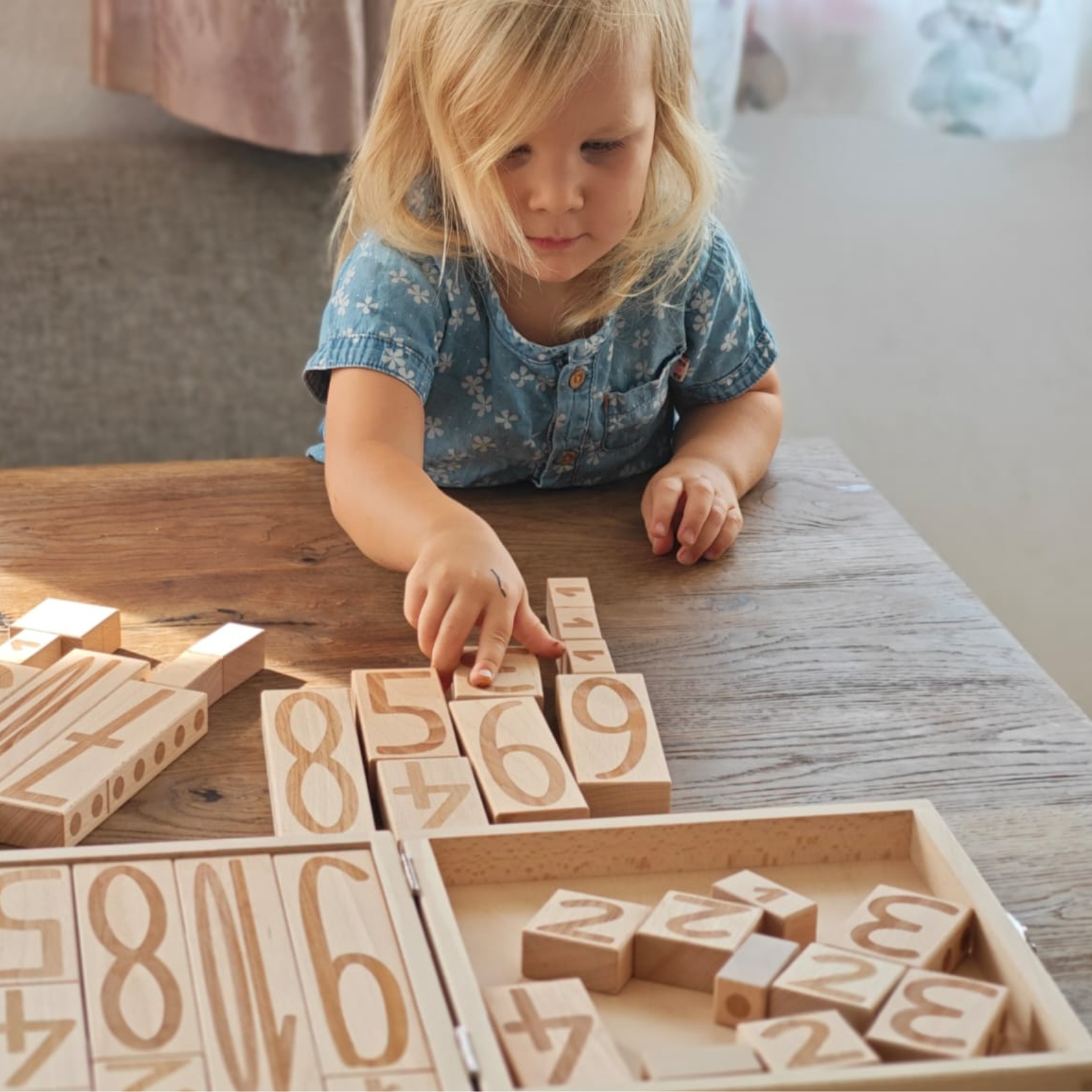
Numbers
Children can recite the number sequence from 1 to 10 very early. But do they understand what, for example, 4 means? Or can they name the numbers individually? As an adult, you may know this from foreign languages. Many people can recite the number sequence in another language but don’t know the individual numbers.
When a child wants to learn numbers, you can lay the blocks with the number side up or stand them up and ask for individual numbers. For example, 'Show me the 7!' It gets harder when you point to a number and ask: 'What is this number?' If the child can already count, they can turn the block over themselves and see how the corresponding number looks as a digit.
All numbers greater than 10 are composed. This is the genius of our number system. You don’t have to learn each number, but understand the system behind it.
Very often, children mix up numbers. They can’t remember whether 35 or 53 is which. This is where the box helps, as it allows you to nicely represent all numbers up to 100. Another help is the number cards, which are available as a download in the shop.
For representing and calculating numbers over 100, I’ve created a few germand YouTube videos.
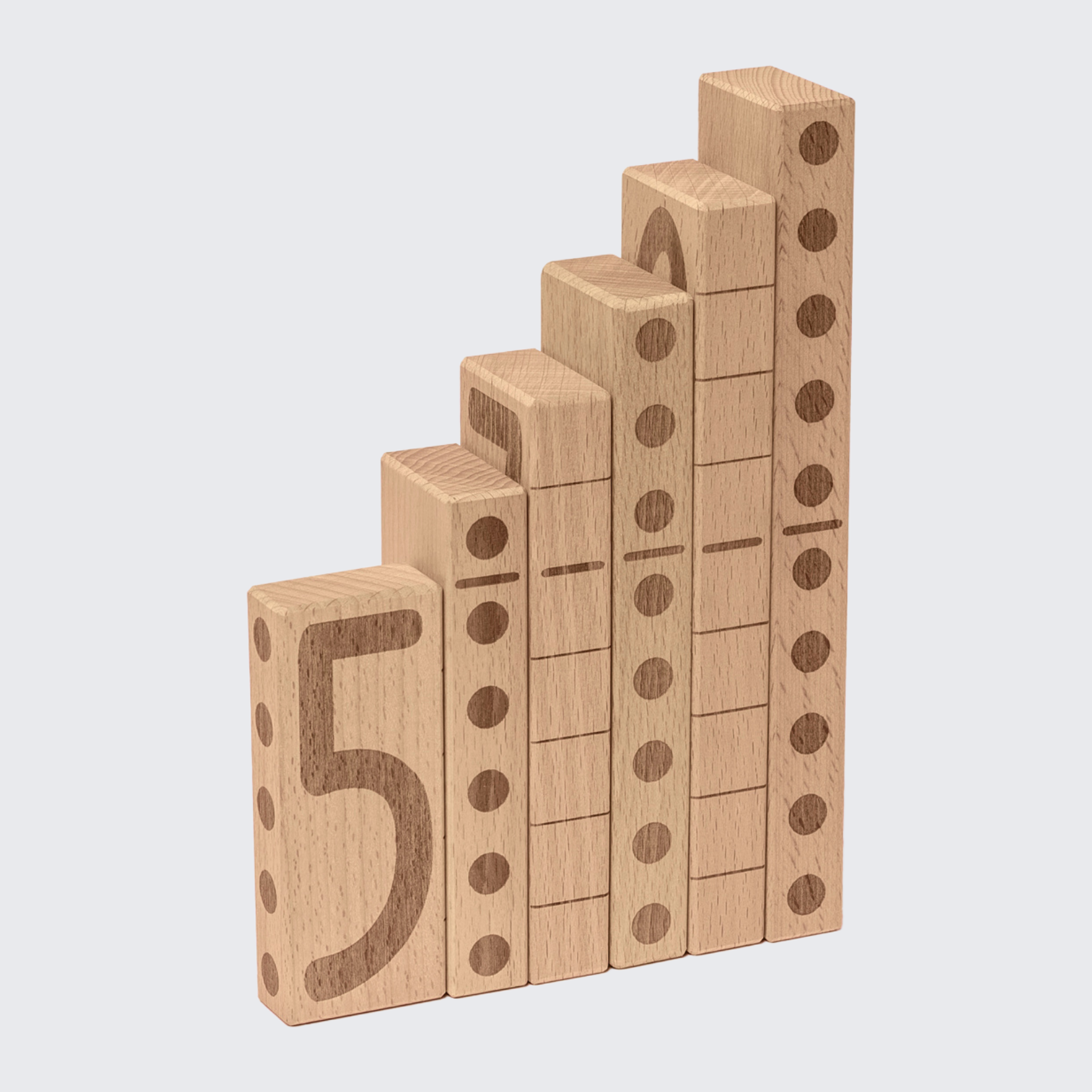
Quantity recognition
For later calculations, recognizing quantities and the associated number relationships is critically important. Which number is greater, smaller, equal, or 2 greater is essentially asking which number is more, less, the same, or 2 more, etc. With Intuitibrix, the child can see that a number is not only greater, but also more.
It is important that the child can recognize a quantity at a glance and doesn’t have to count the fields each time. Since we can normally only recognize quantities up to 5 at a glance, the blocks from 6 to 10 have a wider line at the height of 5. This makes calculations with tens transitions simpler, for example.
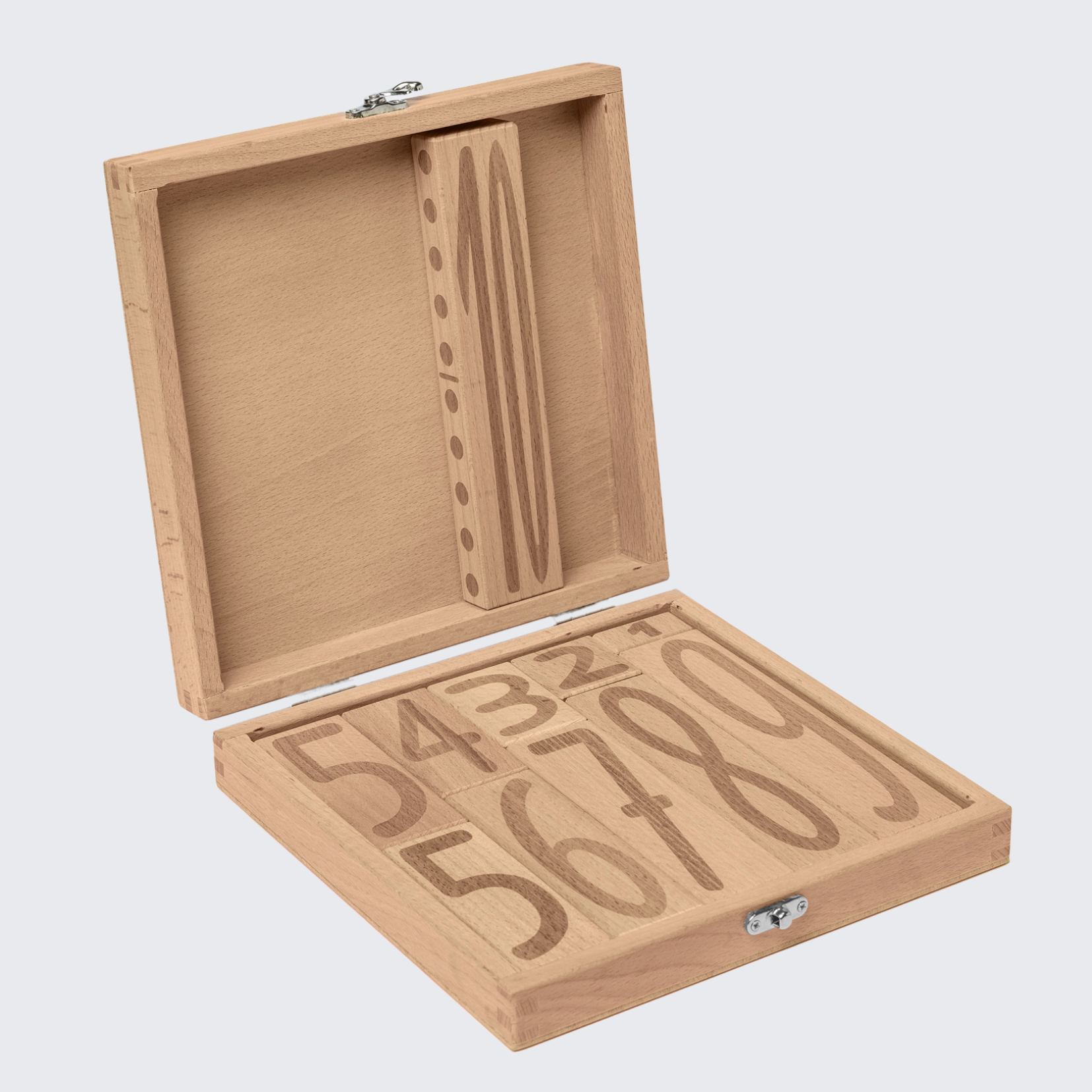
Practicing tens decomposition
When putting the blocks into the box, the decomposition of ten is automatically practiced. Ten blocks must always be placed in a row. The blocks can be arranged upright or flat. There are many possibilities. For example, some children have noticed that you need only half as many twos as ones or that with some numbers, you simply can’t fill the row completely (e.g., with threes).
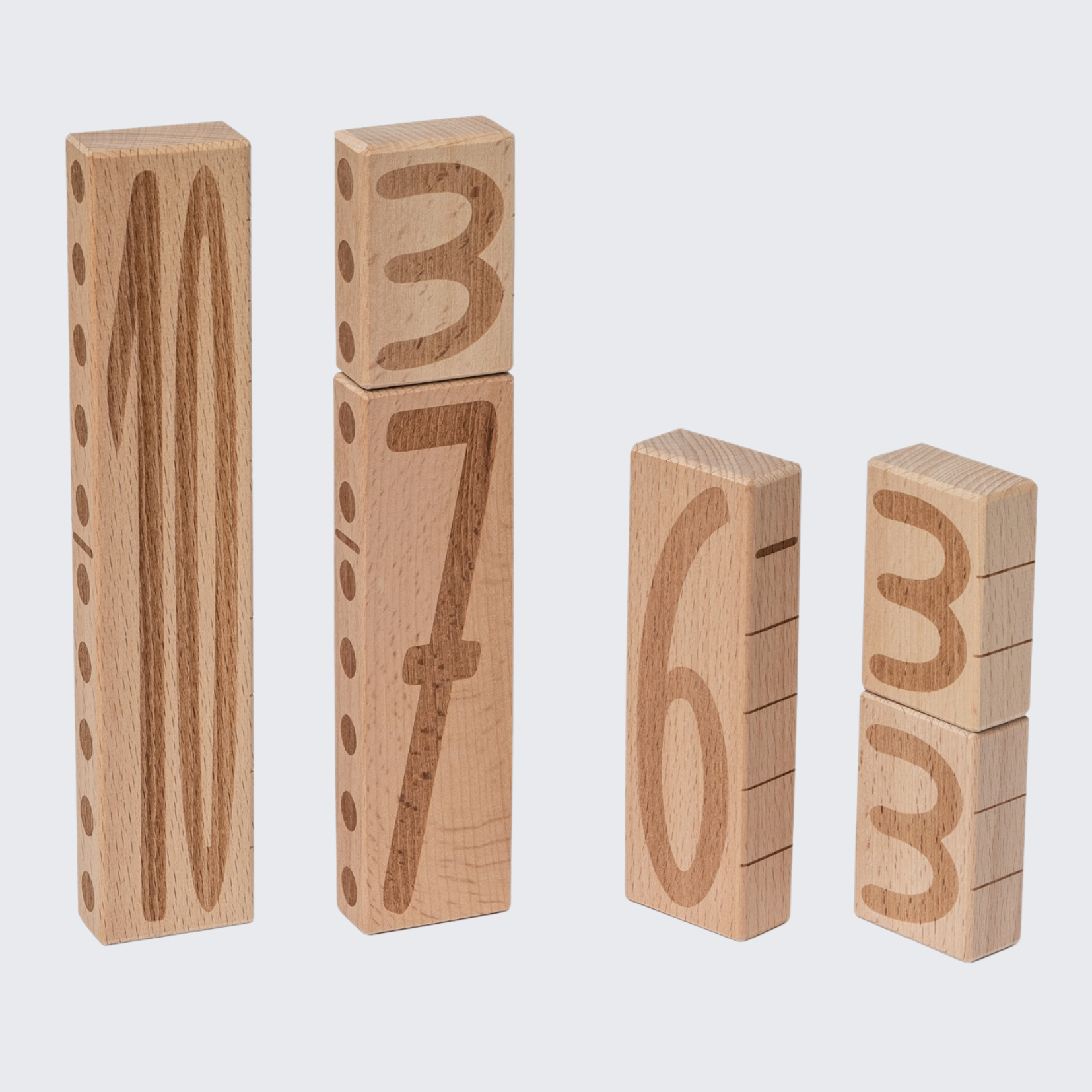
The material is based on the principle that equal height = equal amount. However, this doesn’t mean that addition can only be understood with towers of equal height. It can also be observed that, for example, 4 + 3 is smaller than 8. This is a type of problem that often causes significant issues in school. (4 + 3 < 8) If a child places the 8 next to the tower made of 4 and 3, you could ask what they notice. To encourage the child to think, you could ask: What if…
- you replace the 4 with a 5?
- you replace the 3 with a 5?
- you replace the 8 with a 7?
And so on.

Subtraction means taking away. But how can I take something away from a fixed block? This is a question that can be discussed well with the child. Many children come up with good ideas. If not, one option would be to place the number you want to subtract directly on top of the original number. The result can be read from the remaining spaces. There is a suitable video on YouTube: 'Subtracting with Intuitibrix.
Once children understand how addition and subtraction are related, subtracting becomes easier.
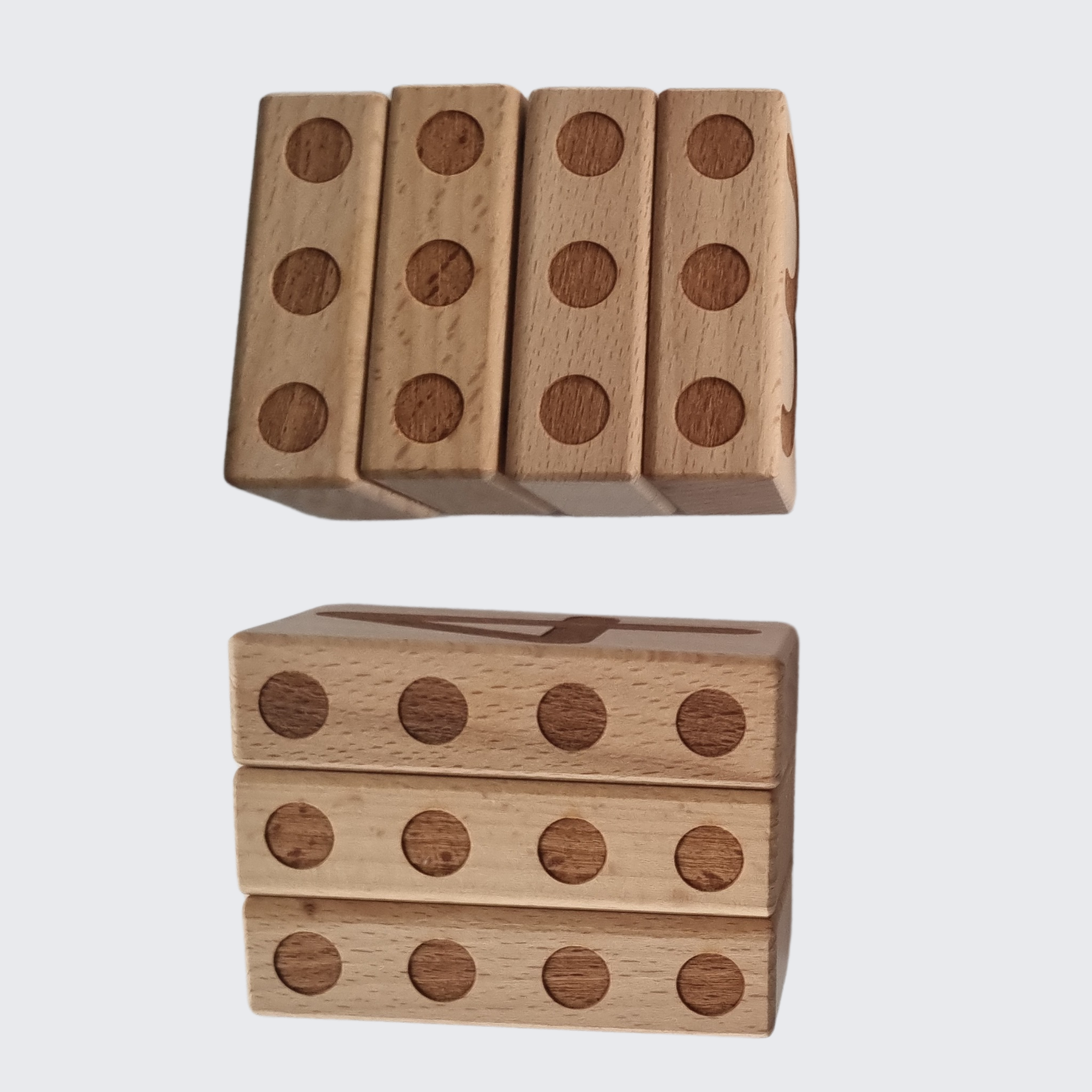
In multiplication, the same amount is taken multiple times, for example: 4 + 4 + 4. What can be discovered? For instance, you can figure out how high three fours are. They are as high as a ten and a two, or as high as two sixes, or as high as four threes, or as high as twelve ones.
For first experiences, the basic set is sufficient. Some children have even figured out how to replace missing blocks with others. For example, instead of a 7, you can use a 3 and a 4. It’s even easier if you use the Intuitibrix minis. In this set, each number is available 10 times.

In division, there are two methods that look the same on paper.
For example, 12 : 3 =
I place the 12 (tens and twos) and experiment to see how many threes I need to make the towers the same height.
I lay out the 12 with ones and distribute them among 3 people. Each person gets 1 until there are no more. How many blocks does each person get?
In both methods, you can use any numbers. What happens when I try to calculate 11 : 3?
No matter how many threes I use, it will never be the same height.
If I distribute 11 ones among three people, there will be 2 ones left over.
For understanding division, it’s very important to start with calculations that have a remainder.
The material is based on the principle that equal height = equal amount. However, this doesn’t mean that addition can only be understood with towers of equal height. It can also be observed that, for example, 4 + 3 is smaller than 8. This is a type of problem that often causes significant issues in school. (4 + 3 < 8) If a child places the 8 next to the tower made of 4 and 3, you could ask what they notice. To encourage the child to think, you could ask: What if…
- you replace the 4 with a 5?
- you replace the 3 with a 5?
- you replace the 8 with a 7?
And so on.
Subtraction means taking away. But how can I take something away from a fixed block? This is a question that can be discussed well with the child. Many children come up with good ideas. If not, one option would be to place the number you want to subtract directly on top of the original number. The result can be read from the remaining spaces. There is a suitable video on YouTube: 'Subtracting with Intuitibrix.
Once children understand how addition and subtraction are related, subtracting becomes easier.
In multiplication, the same amount is taken multiple times, for example: 4 + 4 + 4. What can be discovered? For instance, you can figure out how high three fours are. They are as high as a ten and a two, or as high as two sixes, or as high as four threes, or as high as twelve ones.
For first experiences, the basic set is sufficient. Some children have even figured out how to replace missing blocks with others. For example, instead of a 7, you can use a 3 and a 4. It’s even easier if you use the Intuitibrix minis. In this set, each number is available 10 times.
In division, there are two methods that look the same on paper.
For example, 12 : 3 =
I place the 12 (tens and twos) and experiment to see how many threes I need to make the towers the same height.
I lay out the 12 with ones and distribute them among 3 people. Each person gets 1 until there are no more. How many blocks does each person get?
In both methods, you can use any numbers. What happens when I try to calculate 11 : 3?
No matter how many threes I use, it will never be the same height.
If I distribute 11 ones among three people, there will be 2 ones left over.
For understanding division, it’s very important to start with calculations that have a remainder.




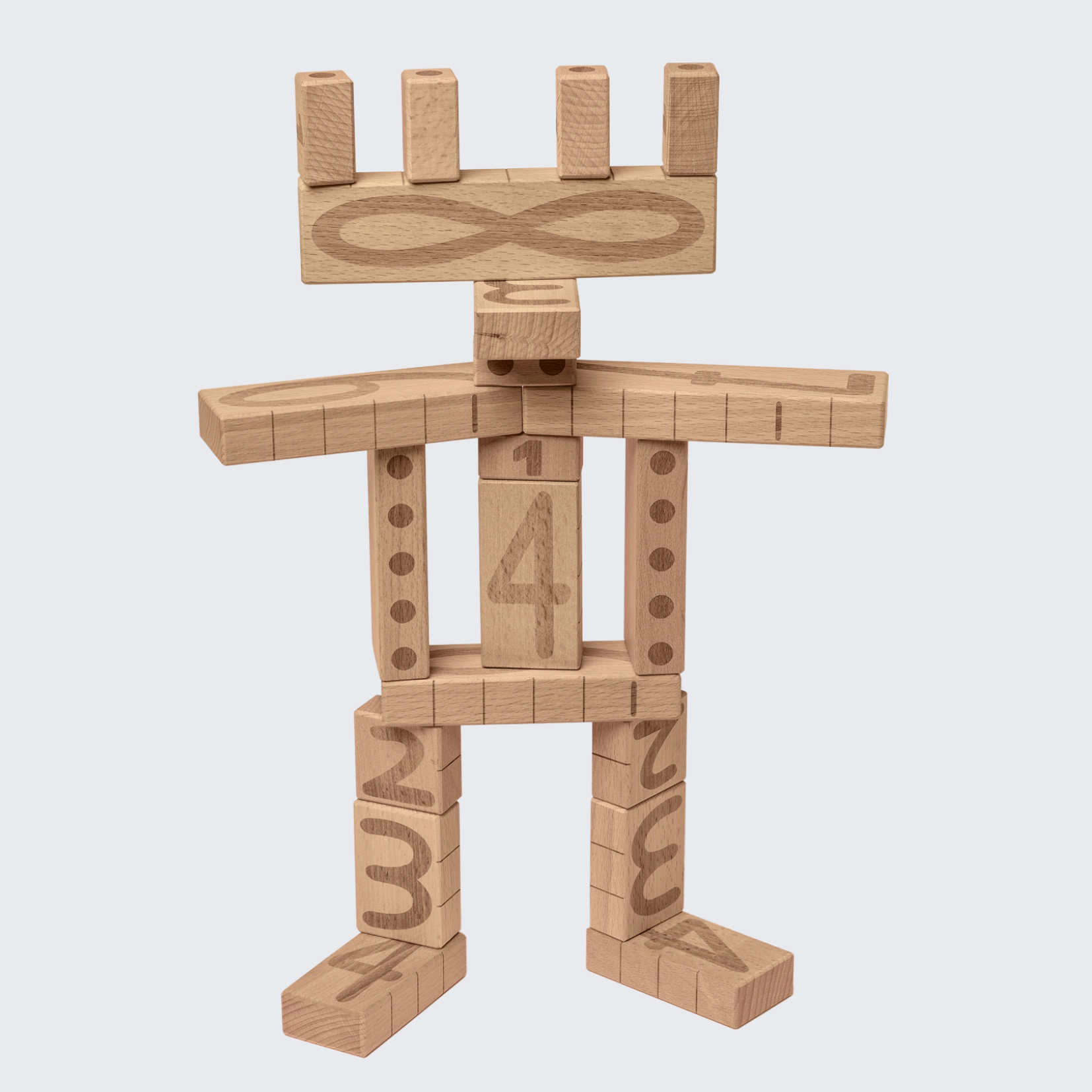
Symmetry
Many children often build symmetrical or mirror-image figures on their own. You can encourage them by placing a larger block in the middle and having the child place the same block on both the left and right sides. A popular example of a symmetrical figure is the butterfly.
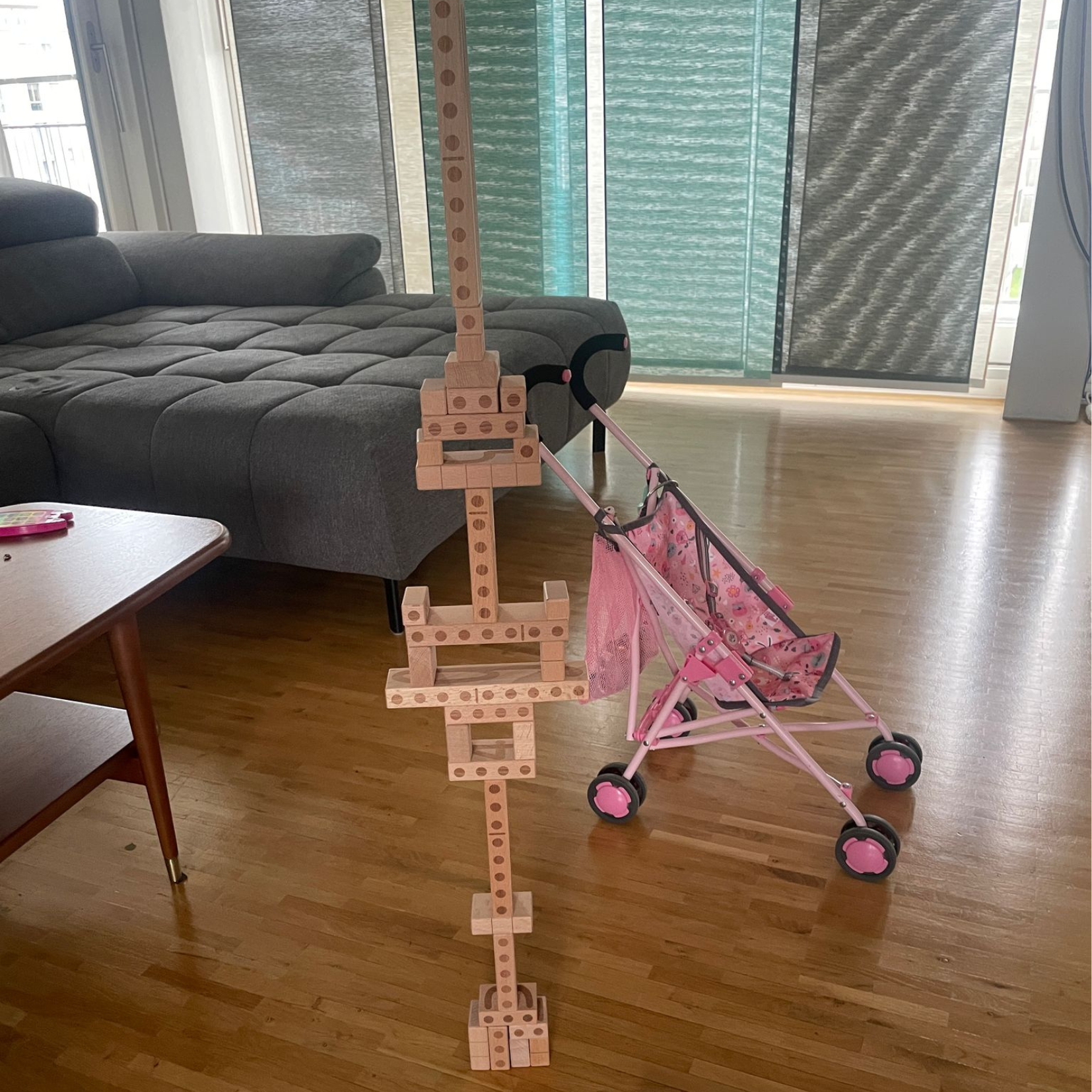
Constructions
Three-dimensional building is an important foundational experience. Children who have never built before may later struggle to read two-dimensional plans. Many children simply enjoy building. If a child ever runs out of ideas, you could build a structure and have the child continue or recreate it. A challenging extension would be to trace the building or create plans. A good preparatory exercise for this is the game 'City of Towerbrix.' It is available in the shop as a game or download.
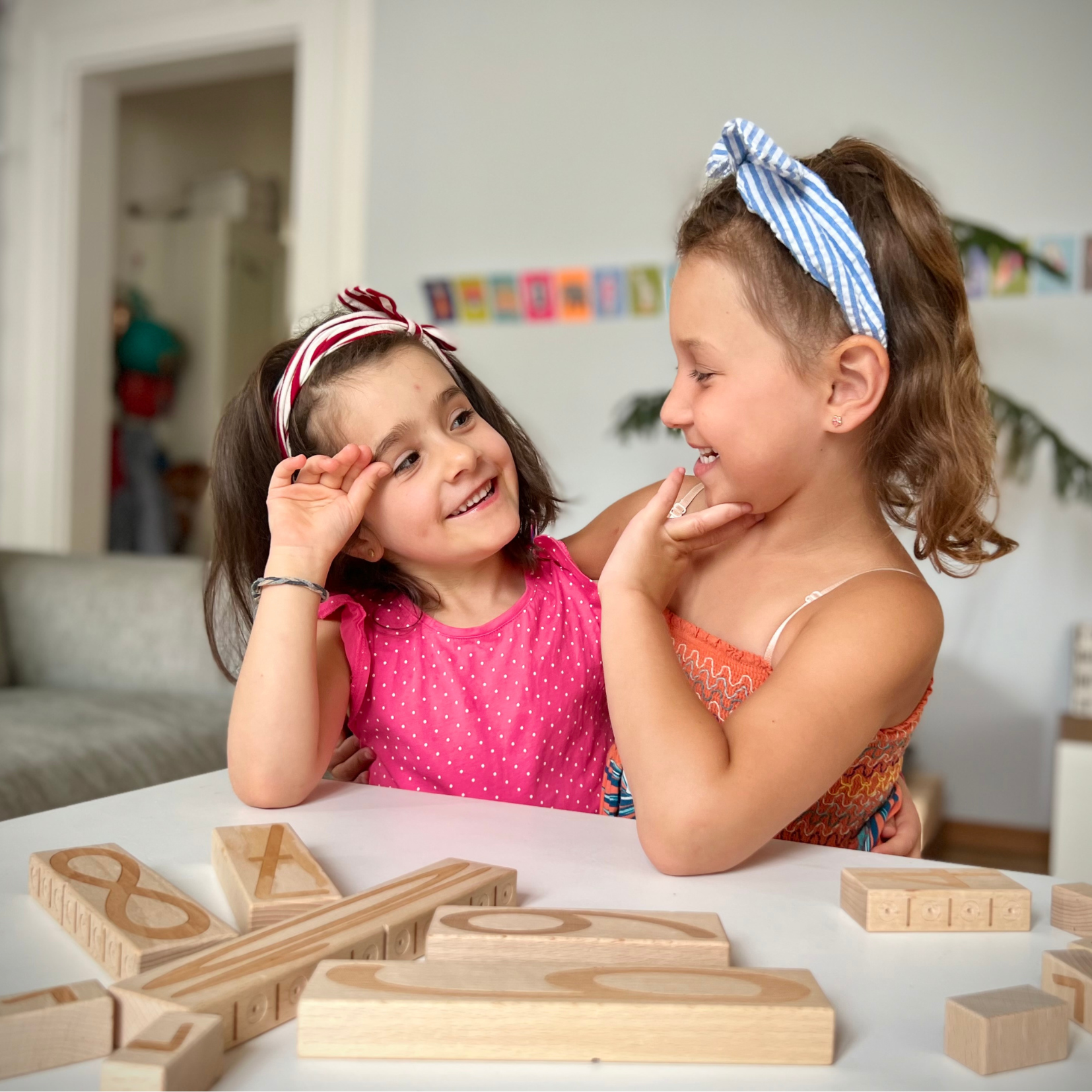
Fostering creativity
Often underestimated, but creativity is an important part of children's education. Creative children are more curious and brave when it comes to trying things out, are better at developing their own ideas, and learn to think problematically.
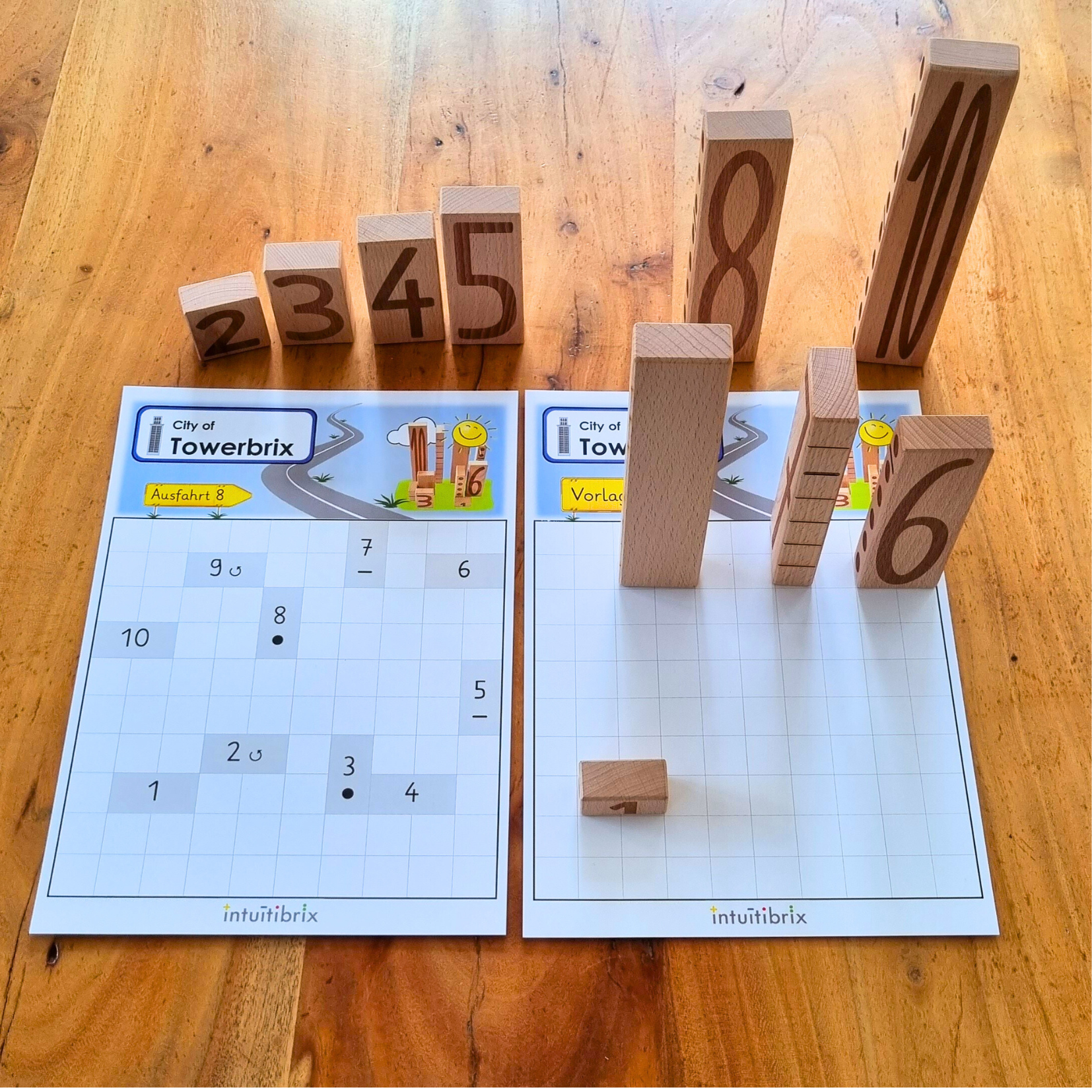
Fostering fine motor abilities
For children's development, it's important that they are allowed to do a lot with their hands. The Intuitibrix blocks are large enough that even young children can build with them easily. Depending on their age and prior experience, the constructions become more complex and wobbly. The game City of Towerbrix also challenges children to handle the building blocks skillfully.
Special features"
Most learning materials on the market consist of exercises where children practice. Without understanding, this only leads to frustration. You practice and practice, but the success just doesn’t come.
The Intuitibrix blocks are different.
- Through the connection of number, quantity, and size, children recognize mathematical relationships while playing.
- The quantity sides allow for self-checking by counting or, even better, by simultaneous recognition.
- The digits are aligned with the curriculum. Therefore, there is a different version in Switzerland than in Germany/Europe
- Digits, dots, and lines can be felt.
- The thicker line at the height of five allows all numbers to be recognized at a glance.
- The number of blocks is designed so that one Intuitibrix set in the box or fabric bag exactly matches the quantity of 100.
- With Intuitibrix, there are endless possibilities.
Children love Intuitibrix.
